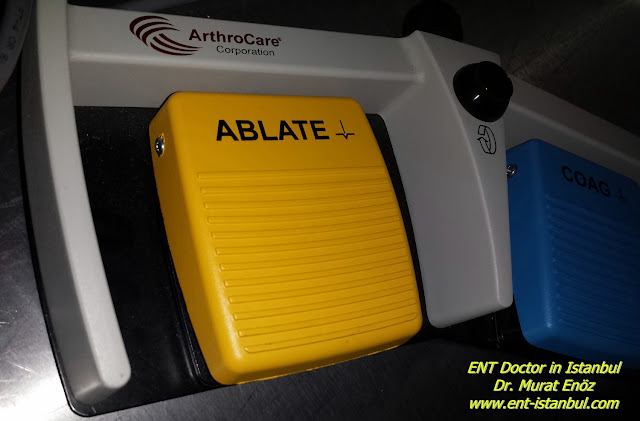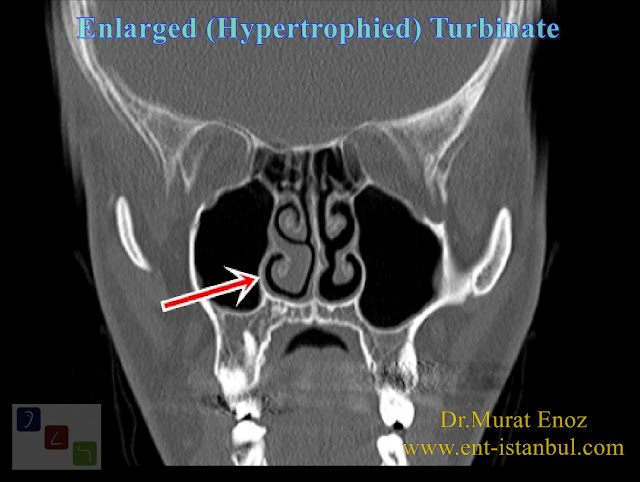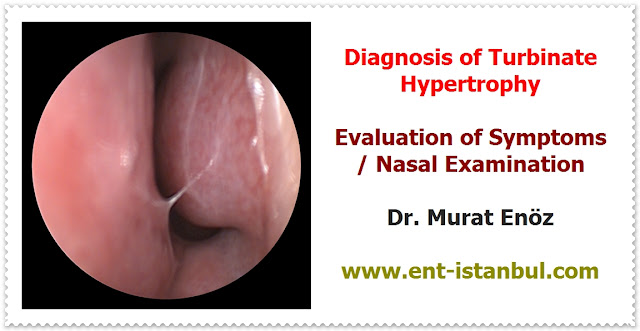Excessive Growth or Enlargement of The Turbinates
Turbinate Hypertrophy Definition
Inside our nose, there are unique, perfectly designed cylindrical or oval-round shaped structures called "turbinates" in changing the air flow entering the nose, flow velocities and flow directions. There are 3 turbinates (inferior, middle and superior tubinate) in each nasal cavity. Especially the lowest inferior tubinates are the most functional ones. Turbinates are the first to encounter external air when we draw air into our nose, and turbinates take part in making this air suitable for the lungs, that is, "warm, humid, pressurized and clean air". Turbinates can grow due to contact with allergens, chronic infections, contaminated air contact, hormonal or genetic reasons, and this condition is called "Turbinate Hypertrophy - Enlarged Turbinates - Hypertrophied Turbinate". When the turbinate volume increases abnormally, it may cause an abnormal increase in intranasal airway resistance and nasal congestion.
Recently, it has been emphasized that this unique structure should be accepted as an "organ", only the existing structure should be reduced in size and surgical partial or complete excision should not be performed in the treatment of hypertophic turbinate. Surgical removal of the turbinates or making them abnormally small may result in a dysfunctional nose (empty nose syndrome) and nasal hyperventilation. You can browse the links on this subject >>Surgery of the turbinates and “empty nose” syndrome (nih.gov) / Overreduction of Turbinate - Nasal Hyperventilation (ent-istanbul.com)
Turbinate Hypertrophy Symptoms
Enlarged inferior turbinates leads to increase of nasal airway resistance and nasal congestion.
Symptoms of turbinate hypertrophy include:
- Congested or blocked nasal breathing
- Breathing trouble at night and snoring
- Sleeping with the mouth open
- Dry mouth
- Reduction in exercise capacity
- An increase in gum disease
- Difficulty wearing a nasal CPAP mask
Why is it important for turbinates to grow and block the intranasal airway?
Our nose ensures that the outside air is suitable for the lungs. Turbinates are the structures mainly responsible for nasal functions. Temporary and permanent hypertrophy of turbinates may occur when there is dirty, particulate, high allergen concentration, extremely dry or cold outdoor air. People living in such an environment need healthy turbines. Medicines and procedures that reduce the volume of turbinate can cause serious problems in people living in these environments. For example, when turbinates are reduced, the intranasal air passage increases, and when they are excessively reduced, nasal hyperventilation and empty nose syndrome may occur.
Causes of Turbinate Hypertrophy
Enlargement of turbinates can occur due to the following reasons:
- Allergic rhinitis (inflammation associated with allergies)
- Chronic sinusitis
- Second-hand smoking
- Chemical irritants.
- Vasomotor rhinitis
- Drugs (Overuse of topical and oral decongestants / Rhinitis medicamentosa)
- Hormones
- Septal deviation (that creates air space in the nasal cavity, turbinate which in the bigger air space side become to grow larger).
In particular, during allergic rhinitis and viral upper respiratory tract infections, transient enlargements of the turbinates may normally be seen. However, when factors causing turbinate growth are consistently present, permanent hypertrophy may be inevitable. For example, if there is constant allergen contact and the patient is unable to change the external environment and avoid allergen exposure or does not receive medical treatment for the allergy, the growth of the turbinate may gradually increase. The same is true in the case of recurrent upper respiratory tract infections and recurrent sinusitis attacks.
Unique, Magnificent Textures - Structures So Special as Organs: Turbinates
It is very important that the turbinates are healthy and of normal size in a dirty, germ, dry or cold environment. Not only should they be large enough in volume, they should have a healthy and moist mucous layer on them, sufficient blood circulation and temperature, healthy functioning of cilia on the epithelial surface, and a healthy mucosal blanket layer should be constantly produced and cleaned. The operation of turbinates may be more complicated than you might think when you first think about it. I can explain this as follows:
- When air is inhaled into the nose, turbinates, which are almost round to sausage-shaped, cause the air to rotate and move backwards by slowing down.
- As the air flow slows down, the contact time with the turbinate surface increases and due to the intense capillary circulation, it works like a "warm heating surface" and the air is gradually heated.
- Allergens, particles and microbes in the air that hit the mucus layer outside the turbinates with the rotation movement, adhere to this layer, the cilia working like whips outside the turbinates push the mucus layer back and we swallow this layer without realizing it. While the new clean mucus layer is produced, the contaminated mucus layer is transmitted to our stomach and the cleaning is completed by contacting the acidic contents of the stomach.
- As the air flow goes backwards, it is humidified and pressurized at the same time.
Specifically, as the outside air moves through the nose, it is heated, filtered, humidified and pressurized. In this way, it is ensured that the end airways of the lungs are opened and oxygen absorption is at the highest level.
Nazal hava akımı incelemelerinde, burun girişine giren havadaki laminer ve çalıştırmael ilerlemeye rehberlik eder. Bua konu ile ilgili olarak ayrıntılı bilgiler bulabileceğiniz link >> Human Nasal Airflow
It is necessary to think many times before having the procedures that include turbinate resections and cause permanent tissue reduction!
Nasal septum deviation and compensatory turbinate hypertrophy
The 2 photographs above show the right inferior turbinate hypertrophy (red and yellow arrows) and the nasal septum deviation to the left. Generally, in patients with nasal septum deviation, turbinate hypertrophy occurs in the passage with a large air passage in the nose, in order to slow down the current air flow and to humidify, purify, pressurize and heat the air entering the nose. Especially in patients with severe nasal septum, when highly asymmetrical air volumes occur in the nasal air volumes, inferior turbinate hypertrophy may be more pronounced on the side with large volume. Perhaps with the contrary idea, more air entering the large or wide nasal cavity, more allergens or microorganisms entering, more nasal mucosa drying can cause this situation. You can look detailed links >> Compensatory hypertrophy of the contralateral inferior turbinate in patients with unilateral nasal septal deviation. A computed tomography study - PubMed (nih.gov) / Histopathology of the Inferior Turbinate With Compensatory Hypertrophy in Patients With Deviated Nasal Septum - Berger - 2000 - The Laryngoscope - Wiley Online Library
Nasal Septum Perforation May Cause Turbinate Hypertrophy!
The nasal septum is the structure that vertically divides the nasal cavity into two. During nasal surgeries, the nasal septum may be perforated (iatrogenic nasal septum perforation), and holes may occur in the nasal septum after cocaine use or trauma. When nasal septum perforation occurs, serious acceleration and flow pattern changes occur in the airflow velocity entering the nose. Especially in large septal holes, the diagonal linear airflow may strike the turbinates, causing them to approach towards the inside of the hole and enlarge to narrow this area. When the turbinates are hit by fast, dirty and cold air, reflex hypertrophy occurs (compensatory inferior turbinate hypertrophy). The wonderful cycle here is to protect the lungs and prevent this dirty, cold, dry and unpressurized air from reaching the lungs. As seen in the photo above, there is a large perforation in the nasal septum and drying, bleeding and crusting in the mucosa around the perforation edges. Unfortunately, there are surgeons who prefer to cut the inferior turbinates and transplant them as free grafts during the surgical repair of these perforations. In this case, although the nasal septum is repaired, the humidifying, warming, purifying and pressurizing organs will be permanently disabled. I prefer repair techniques using rib cartilage, local mucosal flap techniques, tragal cartilage and aurchular cartilage grafts or temporalis fascia for my patients with nasal septum perforation. I don't prefer to do any kind of surgery on turbinates. In patients with septal perforation, compensatory turbinate hypertrophy provides protection of the mucosa of the lower respiratory tract and lungs due to accelerated airflow, preventing mucosal desiccation, damage and infections. The mechanism here is protective and may cause nasal congestion in patients.
Diagnosis of Turbinate Hypertrophy
Turbinate hypertrophy diagnosis can be made by ent doctor with a thorough evaluation of symptoms and nasal examination. Computed tomography is usually not necessary for diagnosis. However, in the presence of septal deviation, chronic sinusitis, nasal polyps and intrasal mass lesion the paranasal computed tomography may be required.
During the endoscopic examination, the volume of the turbinates, whether they are in contact with the nasal septum, the color of the overlying mucosa and whether it is healthy can be evaluated. In a patient with an attack of allergic rhinitis, while the turbinates are pale and edematous, it can be seen that there is increased secretion in transparent color on them. During viral upper respiratory tract infections and acute sinusitis, turbinbnates may be seen to have a more reddish color and a thick or inflammatory secretion over them.
Medical Treatment Options For Turbinate Hypertrophy
The following drugs and measures are appropriate in the turbinate hypertrophy:
- Nasal irrigation with hypertonic saline (very salty water)
- Allergen avoidance and proper treatment of allergic rhinitis
- Avoidance of cigarette smoke (second-hand smoking) and chemical irritants
- Topical nasal steroid sprays
- Topical nasal decongestant sprays (for only a few days)
- Oral decongestant (for only a few days)
Turbinate Surgery (Turbinate Resection)
There are many methods for reducing of the concha. Concha surgery is one of them. Turbinate surgery can be performed with conjunction of septoplasty. Generraly partial resection of the concha performed via submucosal way. Microdebrider resection can be also used for it. It is important that the turbinate not be removed completely because its removal can cause to deterioration of nasal air physiology and it can result in a very dry and crusty nose. In the absence of nasal turbinate, the air that is breathed may not be to adequately humidified, filtered and warmed. Some methods include turbinate bone resection.
Currently, modern minimal invasive technologic methods more favorable than surgical removal of turbinates in turbinate hypertrophy treatment such as cauterization, coblation, radiofrequency reduction. These minimal invasive methods can be applied under local anesthesia in office conditions.
Radiofrequency Turbinate Reduction Procedure
Radiofrequency turbinate reduction (RFTR) is a non-surgical, minimally invasive technique that can reduce tissue volume of the turbinates. In this method, Radiofrequency energy dissipation and damage to the surrounding tissue is minimal. Radiofrequency turbinate reduction technique is well tolerated and effective and it has a low complication rate and has been shown to reduce nasal obstruction secondary to inferior turbinate hypertrophy according to the a systematic literature review (Source: Radiofrequency thermal ablation for patients with nasal ...). RFTA, provides immediate reduction in nasal congestion.
Radiofrequency turbinate reduction (RFTR) is a medical procedure performed to address nasal congestion and related symptoms caused by turbinate hypertrophy. The aim of RFTR is to reduce the size of the nasal turbinates, which are structures inside the nasal passages that help regulate airflow and humidity. This minimally invasive procedure is typically performed by an Ear, Nose, and Throat (ENT) specialist and involves the use of radiofrequency energy to shrink the turbinates.
Here is an overview of the radiofrequency turbinate reduction procedure:
1. Initial Assessment: Before undergoing RFTR, a patient will have an initial consultation with their ENT specialist. During this assessment, the specialist will review the patient's medical history, evaluate their symptoms, and conduct a physical examination of the nasal passages to determine if RFTR is a suitable treatment option.
2. Pre-operative Preparations: If RFTR is deemed appropriate, the patient will undergo pre-operative preparations. This may include avoiding certain medications or supplements that can increase the risk of bleeding and following any specific instructions provided by the surgeon.
3. Anesthesia: RFTR can be performed under local or general anesthesia, depending on the patient's preference and the surgeon's recommendation. Local anesthesia numbs the nasal area, while general anesthesia induces a temporary state of unconsciousness during the procedure.
4. Procedure Steps: The steps involved in RFTR can vary slightly depending on the surgeon's preferred technique. However, the general procedure involves the following:
a. Accessing the Turbinates: The surgeon typically inserts a small, specialized instrument called a radiofrequency probe into the nasal passages. This can be done through the nostrils without the need for external incisions.
b. Applying Radiofrequency Energy: The radiofrequency probe delivers controlled energy to the tissues of the nasal turbinates. This energy heats the tissues, causing them to shrink and reducing their overall size.
c. Monitoring and Adjusting: Throughout the procedure, the surgeon monitors the effects of the radiofrequency energy and makes any necessary adjustments to achieve the desired reduction in turbinate size.
5. Post-operative Care: Following the procedure, the patient will be monitored in a recovery area. They may experience mild discomfort, nasal congestion, or temporary nasal drainage. Pain medication and nasal sprays may be prescribed to manage these symptoms. The patient will receive specific post-operative care instructions, which may include guidelines for nasal hygiene and follow-up appointments with the surgeon.
6. Recovery and Results: The recovery time after RFTR is generally short, with most patients able to resume normal activities within a few days. It may take several weeks for the full benefits of the procedure to be realized, as the nasal tissues heal and any swelling subsides. Patients typically experience improved nasal airflow, reduced congestion, and relief from related symptoms such as snoring or sleep disturbances.
It's important to note that the specific details of the RFTR procedure can vary depending on the surgeon's techniques and preferences, as well as the patient's unique circumstances. Patients should consult with their healthcare provider or ENT specialist to obtain detailed information about the procedure, its benefits, potential risks, and expected outcomes.
An Important Information About Turbinate!
Turbinates are tissues inside our nose that purify the air, warm the humidifier and make it pressurized. It should be regarded as a unique "organ". Abnormal reduction or surgical removal of these tissues may cause permanent health problems (such as empty nose syndrome). You can find detailed information on this topic >> Why Turbinates Are Important? - Empty Nose Syndrome
Radiofrequency Turbinate Reduction Videos:
Radiofrequency Turbinate Reduction Video - 1:
Radiofrequency Turbinate Reduction Video - 2:
Coblation Turbinate Reduction
 |
| Coblation Turbinate Reduction |
Coblation® turbinate reduction procedures use a Coblation-channeling®
technique designed to simultaneously remove and shrink submucosal
turbinate tissue while leaving the mucosal lining virtually
undisturbed (Source:
ArthroCare ENT: Turbinate Reduction - A minimally invasive ...).
This method is more expensive than the radiofrequency reduction.
 |
| Coblation Turbinate Reduction |
 |
| Coblation Turbinate Reduction |
 |
| Coblation Turbinate Reduction |
Turbinate tissue can re-grow after turbinate surgery and
turbinate reduction in patients especially those living in environments where the particles are allergenic. The procedures may need to be repeated.
Coblation Turbinate Reduction Video:
Link group where you can read articles about turbinate published on this website >> https://www.ent-istanbul.com/search?q=turbinate
Source links:
Radiofrequency Turbinate Reduction
Radiofrequency Ablation of Hypertrophied Nasal Turbinates
Radiofrequency tissue reduction for turbinate hypertrophy
Turbinate Hypertrophy | Conditions and Treatments ...
What Is the Best Method for Inferior Turbinate Hypertrophy ...
Turbinate Hypertrophy | Department of Otolaryngology ...
Murat Enoz, MD, Otorhinolaryngology, Head and Neck Surgeon - ENT Doctor in Istanbul
Private Office:
Address: İncirli Cad. No:41, Kat:4 (Dilek Patisserie Building), Postal code: 34147, Bakırköy - İstanbul
Appointment Phone: +90 212 561 00 52
Appointment Phone: +90 212 561 00 52
Fax: +90 212 542 74 47













Comments
Post a Comment